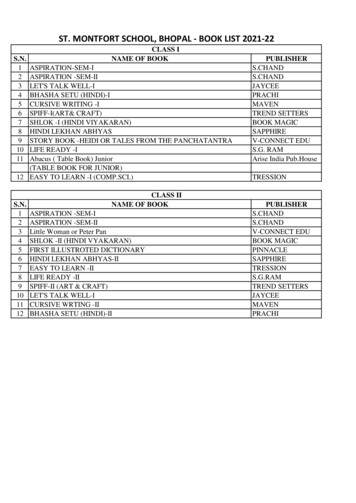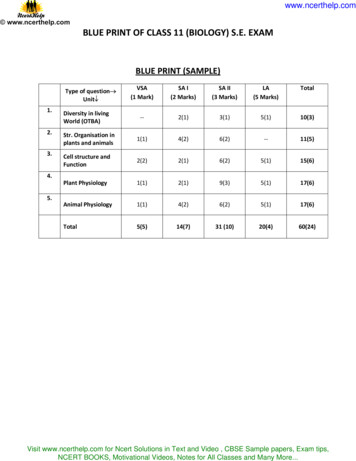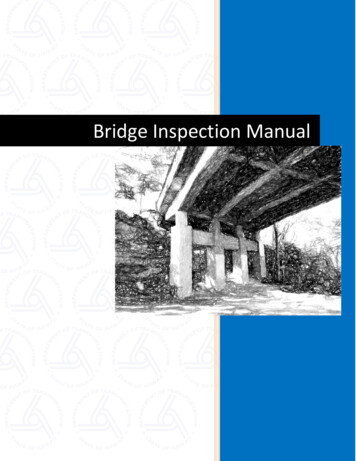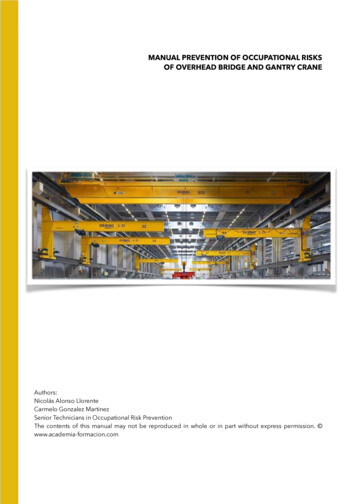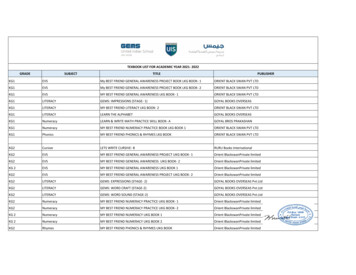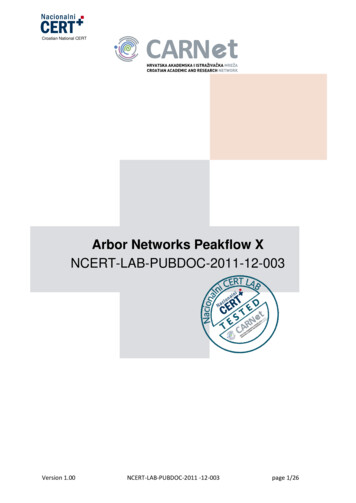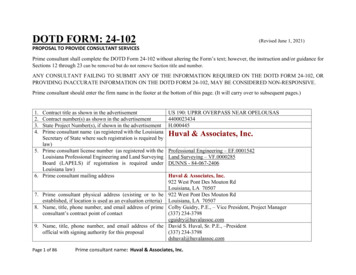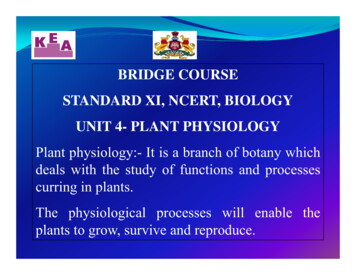
Transcription
BRIDGE COURSESTANDARD XI, NCERT, BIOLOGYUNIT 4- PLANT PHYSIOLOGYPlant physiology:physiology:- It is a branch of botany whichdeals with the study of functions and processescurring in plants.plantsThe physiological processes will enable theplants to grow, survive and reproduce.
Some of thefundamental physiological processes are;1. Absorption of nutrients from the environement.2 Transport of nutrients within the plant system2.system.3. Photosynthesis4. Respiration5 Growth and development5.
Chapter11, TRANSPORT IN PLANTSChapter-11,From the stage of germination to detath, plantscontinuously involve in utilizing gases,gases minerals andwater from air and soil. Water and mineral ions areabsorbedabsobed by tthee rootoot hairsa s fromo tthee sosoil aandd gases likeecarbon dioxide and oxygen enter the plant systemthrough stomata/lenticells. The absorbed nutrientshave to be transported to all the cells of the plant forthe cellular physiological process to happen smoothly.
Transport:- The movement of absorbed water andmineral ions within and between the cells is called‘transport’1. Diffusioniff i2. Facilitated diffusion,3. Active Transport,4 Osmosis4.Oi andd5. Imbibition are various transport machanisms seen inplants.
Diffusion:Diffusion:- It is defined as the movement of solid,solid gasor liquid molecules from the region of their higherconcentration to the region of lower concentration,without the expenditure of energy (passivemechanism). The molecules move randomly till theequilibriumilib ii established.ist bli h d TheTh sppedd off theth processincreases with increase in temperature andconcentration gradient.gradient
y –ExperimentpActivity-1to demonstrate difussion.Put few crystals of copper sulphate in a beaker of water.After some time you observe the gradual change inthe colour of water. Water turns blue as coppersulphatepcrystalsydissolve and spreadpfrom the bottomof the beaker up words. i.e, molecules have movedfrom the region of their higher concentration to theregion of their lower concentration. The moleculesspread in water slowly and randomly till theequilibrium is establishd.establishd
ances are transported across the cellmembrane along the concentration gradientwith the help of membrane proteins, withouttheexpenditureofenergy(passivemechanism), Th is called ‘facilitated difusion’.
Active transport:- It is the transport ofmolecules by membrane proteins against theconcentration gradient by spending energy(active mechanism). During active transportATP is used as the source of energy. Activetransport is often seen when the mineralcontent in the soil is lesser than that present inthe root. The uptake of mineral ions takesplace by active transport method.
Water potential:- The chemical potential ofwater is known as ‘water potential’. It is theamount of free energy available per mole ofwater in a system.The greater theconcentration of water molecule in a system,higher will e the kinetic energy of watermolecule and hence, higher will be the waterpotential. Water potential is denoted by ‘Psi’or φ. pure water has the highest water potentialand it is zero. All solutions have a waterpotential less than that of pure water and φvalue will be negative.
Water solute solutionThe water potential of a system may be defined as thedifference between the free energy of water in thatsystem and the free energy of pure water atatmospheric pressure and a defined temperature. Thecomponents off water potentiali l ini a plantl cellll areWater potential (φ w) Solute potential(φ s) Pressure potential (φ p)
Solute potential is the amount by which the waterpotentialduet ti l off a cellll decreasesdd tot theth presence offsolute.Pressure potential is the potential created due toturgor pressure developed inside the cell.Osmosis: The diffusion of water (solvent)molecules across a selectively permeablemembrancebffromtheh regionioff higherhi hwaterpotential to the region of lower water potential iscalled ‘osmosis’osmosis (Passive mechanism).mechanism)
Selectivelypermeablemembraneordifferentially permeable membrane is onewhichwc aallowsows oonlyy specspecificc sosoluteute moleculeso ecu es topass though, along with the solvent molecules.biologicalo og cmembranese b es aree seselectivelyec ve yAll bpermeable.
Activity-2Activity 2 –ExperimentExperiment to demonstrateosmosisTake a large sized potato. Peel its skin and scoopp carefully.y Fill the cupp ppartiallyyit into a cupwith 10% sugar solution. Note the level ofg solution in the cupp byy ppinning.g Thensugarkeep the potato cup in a Petri dish containingppure water. After sometime observe the levelof solution inside the cup.
The level of sugar solution increases due toentry of water from petridish to thecupthrough the selectively permeableplasms membrane surrounding the potatocells. Here water has difusedfffromtheregion of higher water potential (petridish)to the region off lower water potential(Potato cup)
Activity-3Activity 3 –ExperimentExperiment to show exosmosisSoak raw mango pleces in saturated salt solution.Observe the size of mango pieces after a week.It shrinks due to loss of water. Movement ofwater from cell to the surrounding medium iscalled ‘exosmosis’. Exosmosis takes placewhen a cell is kept in an ‘hypertonic on is more than that of the cell sap.
Activity4 –ExperimentExperiment to show endosmosisActivity-4Soak raisins overnit in water. Observe the sizeoff raisins.iiI swellsItll dued to entry off water fromfthe surrounding medium. Movement of waterffromtheh surroundingdi mediumdiiintotheh cellll isicalled ‘endosmosis’. Endosmosis takes placewhenhtheh cellll isi keptki an ‘hypotonicin‘hisolution’. Hypotonic solution is one whoseconcentrationi isi lessl thanh thath off cellll sap.
Plasmolysis: It is defined as the withdrawal ofthe protoplast from its cell wall and itsshrinking due to the loss of water (exosmosis)when the cell is kept in a hypertonic solution
PlasmolysisFig 1. CHANGE IN THE SHAPE OF PROTOPLAST WHEN CELLS ARE KEPTIN DIFFERENT TYPES OF SOLUTIONS.
Imbibition: The adsorption of water byhydrophilic colloidal substances withoutformingasolution is called ‘Imbibition’Imbibition .Swelling of dry seeds anda piece of woodwhen soaked in water are examples ofimbibition. Imbibition is a temporary increasein volume of the cell.cell In plant cell sbstancessuch as cellulose, hemicellulose, pectin andlignin can imbibe water.water
TRANSLOCATION:The long distance transport of water and mineralsubstances from root to the shoot systemthrough the xylem vessels and transport ofoorganicga c sosolutesutes ((food)ood) fromo sousourcece ((leaves)eaves) tosink (storage organs) through phoem is calleds oc o . In oothere wowordsds Translocations oc o iss‘translocation’.simply long distance bulk transport ofg vascular tissues.substances through
The translocation of substances through xylemand phloem takes place in ‘enen massmass’ or ‘bulk’bulkconcentration. The mechanism of xylemtransport is being explained by ‘cohesioncohesiontension-transpiration- pull’ theory by Dixonand Jolly.Jolly The Phloem transport mechanism isbeing explained by ‘mass flow hypotheses orpressure flow hypotheses by Ernst Munch.Munch
Activity4 –ExperimentExperiment to show that xylem isActivity-4the water conducting tissueKeep a twig of Balsam plant in a beakercontaining colour (safranine) water. After anhour take a thin section of the stem andhour,observe under the microscope. Only the wallof the xylem vessel would appear red,redindicating that water has moved upwardsthrough xylem.xylem
Fig 2 & 3 diagramFig. 2 & 3 Translocation of water, minerals and organic solutes in vasculartissues
ActivityphloemtranslocatesA ti it 55 ExperimentEit tot showhhltl torganic solutesGrinding experiment to prove phloem is the foodconducting tissue. Remove the bark in the form ofa ring of a well grown plant little above the soillevel. Take care to see that control xylem isretained . After few weeks observe the swelling ofthe stem above the girdle due to accumulation offood. Food cannot move down pphloem has beenremoved causing interruption for the downwardmovement of food.
pp ofRadial transportof water the conceptSymplast and ApoplastThe waterTht andd mineralil ionsith t are absorbedthatb b d bybthe root hairs by passive and active mechanismsreach the Central xylem elements passingthrough cells of epidermis, cortex, endodermisand pencycle.pencycle This transport along the radius ofroot is called ‘radial transport’.
Fig. 4: Radial transport of water fromepidermal cell to xylem.xylem
The movement of water during radial transportmay followeitherf llith one or bothb th theth pathwaysthmentioned below:Symplast pathwayMovement of watergnetwork of livingg material ofthroughcytoplasm (plasmodesmata) is called ‘symplastppathway’.yApoplastic pathwaymovement of waterththroughh theth non livingcellli ill wallsll andd theth middleiddllamella is called ‘apopolast pathway’.
Fig.5.Apoplast and symplast pathways oftransporttt
SUMMARY: Plants require minerals. Water, carbon dioxideand oxygen for their normal growth anddevelopment. They obtain it form soil and air and use it forphysiological activities. The absorption of these substances takes placeby mechanisms such as diffusion, facilitateddiffusion, active transport and osmosis.
SUMMARY: The movement of these absorbed substances withinand between the cells is called transport. Long distance transport of nutrients and the organicsolute synthesised in the leaves through xylem andphloem is called ‘translocation’. Translocation takes place en mass or in bulkirrespective of the concentration of individualsubstances to be translocated.
EXERCISE:i. Define plant physiology?ii. Name the important phsiological process seenin plantsiii.Differentiate between diffusion and facilitateddiffsioniv.WhativWhat is a selectively permeable membrance?Give an example.
v. Differentiate between the following terms.a. Diffusion and osmosisb Activeb.Acti e and passivepassi e transportc. Transportp and translocationd. Apoplast and symplast pathways.e. Imbibition and diffusion.f Endosmosis and exosmosisf.
vi.i DefineD fi watert potential.t ti l WhatWh t isi theth watertpotential of pure water?vii. Name the components of water potential.viii.iii ExplainE l i plamolysis.ll i DrawDa neatt lebelledl b ll ddiagram of palsmolysed cell.
STANDARD XI, NCERT, BIOLOGY UNIT 4- PLANT PHYSIOLOGY Plant physiology:- It is a branch of botany which deals with the study of functions and processes . Chapter-11, TRANSPORT IN PLANTS From the stage of germination to detath, plants continuously involve in utilizing gases, minerals and
